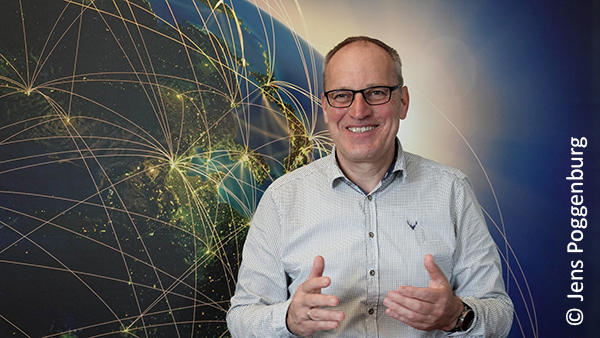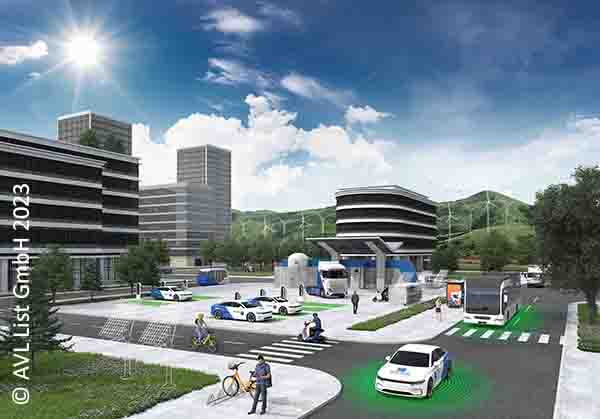
|
The automotive industry cannot develop all the software itselfAn Interview with Jens Poggenburg The automotive industry is facing a number of simultaneous challenges, which are usually described by the acronym CASE, which stands for Connected, Autonomous, Shared and Electric. In an interview with the PROSTEP Newsletter, Jens Poggenburg, a member of the management board at AVL, explains how the global automotive supplier from Graz, Austria is dealing with these challenges. 
Question: "Reimagining Motion" is AVL's maxim. How autonomous do you imagine the mobility of the future will be? Poggenburg: A simple question with no easy answer. We can say for sure that assisted driving is on its way as legislators have already proscribed certain functions. But when talking about the higher levels 4 and 5, you'll notice that all the carmakers and suppliers have scaled back their ambitious targets significantly. I myself think that autonomous driving will make an appearance in the context of specific applications and situations, for example for highways, trucks and perhaps also for local public transport. However, it remains to be seen whether applications such as robotaxis will prevail. Question: The acronym CASE is synonymous with the transformation of mobility. Which letter poses the biggest challenge for German carmakers? Poggenburg: Which CASE element poses the biggest challenge depends on the company in question, its background, and where it currently stands with regard to its development processes. Question: What impact are trends like e-mobility and sharing having on automotive value added and the value chain? Are the roles changing? Poggenburg: Yes, absolutely. What I'm seeing is a multi-dimensional upheaval. The roles between OEMs and Tier 1 suppliers are changing, and new players that operate differently to the established OEMs are also entering the market. And I don't just mean start-ups but also players from China and the west coast of the USA. When it comes to e-mobility in particular, we are dealing with a relevant upheaval in the value chain because Chinese companies have secured extremely comprehensive access to the value chain for battery-electric vehicles. Question: My question also refers to the distribution of value added between suppliers and carmakers. Are OEMs shifting this back to themselves because electric vehicles are cheaper to develop and build? Poggenburg: What you're alluding to is exactly how we see it. OEMs are not only trying to do more themselves in the context of manufacturing but also in the context of development. However, this is not primarily because they want to make sure they have enough to do, but because they want to gain experience with new technologies. 
Question: Does the "Anstalt für Verbrennungskraftmaschinen List" still develop combustion engines and engine testbeds? Poggenburg: Today, we generate two-thirds of our revenues of around two billion euros with new technologies. This is an incredible upheaval. Of course, we still develop combustion engines and also deliver engine testbeds, but always in the context of reducing CO2 emissions. We deliver our technologies, services and simulation tools to wherever legal requirements and regional framework conditions demand it. You've no doubt also been following the news over the last few months, which indicates that instead of a fast switch from the combustion engine to electric mobility there will more likely be a longer transitional period. This makes it all the more important that the emissions from the combustion engines that continue to come onto the market are as low as possible. Question: AVL opened a hydrogen and fuel cell test center in Graz in 2022. Do you have some reservations when it comes to e-mobility? Poggenburg: We see hydrogen technology as being part of e-mobility. There are a variety of studies that say that battery technology may only be a transitional technology. It’s a subject for endless debate. However, the fact remains that hydrogen is totally relevant as an energy source and that it will play a major role in the field of heavy goods transportation, not only as a fuel cell drive but also as a hydrogen engine. In India, for example, not only industry but also the government are making huge investments in this sector. Hydrogen production and distribution are therefore a key infrastructure issue. We are heavily involved in this area because we believe that the new drive technologies have to be viewed from both the perspective of the vehicle and the perspective of the infrastructure as a whole. Question: Measured in terms of revenues, what are currently your largest business and technology areas? Poggenburg: Our strategic business areas are engineering, instrumentation and test systems, and simulation. If you look beyond them, battery electric drives, software-defined vehicles with simulation, and hybridization are our three core technology areas. Question: Simulation is one of AVL's three pillars. Will virtual testing make testbeds obsolete in the future? Poggenburg: We'll never be able to completely replace physical testing with simulation. But there's no question that the time, money and effort required for physical testing can and must be dramatically reduced through the use of simulation. Just think of the number of possible scenarios for autonomous driving – they can't all be tested. Simulation is unrivaled if you want to end up with a manageable number of variants. Question: What role does software and software development play in the context of AVL's business? Poggenburg: First of all, I would like to say that we are not and never will be merely a software company. Our strength will always lie in connecting the software to the domain and to the product. When we talk about software, we're not only talking about the tool chain and automation but also about the software in the vehicle. Software is already playing a key role in terms of investment and development activities – I wouldn't say it accounts for over half of our revenues, but it's heading in that direction. And in the medium and long term, a large proportion of our business volume will depend on software. It's also worth mentioning that around 3,000 employees are already working in the software sector. Question: What are the challenges that some German carmakers are struggling with when it comes to developing vehicle software? Poggenburg: The main challenges are speed, costs and compliance. In software development, we're talking about cycle times that are ten times faster than for the hardware, and the software is subject to an ongoing update process. Another challenge that I consider crucial in this context is identifying, creating and maintaining a suitable network of partners. Not only the carmakers but also we realize that we can't do everything ourselves. Automotive operating systems in particular have undergone major changes in recent months. What the automotive industry want to do on its own in the past, it is now doing together with the big players in the market. And we are also collaborating with partners like Microsoft. Question: Doesn't the decoupling and coordination of software and vehicle hardware development also pose a challenge? Poggenburg: The fact that these processes are decoupled is not the biggest challenge. The real challenge lies in identifying what I need to interlink and where, and how the interfaces for and the frequency of the interaction need to be defined. This requires a very high level of integration know-how and consistent data models, not only between the software and the hardware but also between the physical and virtual worlds. 
Question: How well are hardware and software development integrated at AVL? Is the way you work model-based and agile from end to end? Poggenburg: I would like to answer with a resounding yes, but the reality is that we are also struggling with our legacy. In terms of methodology, my answer is yes. Many years ago, we introduced the Integrated Open Development Platform, which provides a precise description of the methods required to link the different domains. The methodology is currently being implemented, but it is going to take us a year or two, not just a few weeks. What we can say for sure, however, is that we work in an agile way. Question: AVL entered into a strategic partnership with Microsoft last year. What do you expect to gain from this? Poggenburg: There are four main points involved. First of all, we want to significantly accelerate the scaling with which we bring our software solutions to market. The second is that we are able to integrate methods and processes, e.g. in the fields of data analytics and artificial intelligence, in our solutions without having to develop everything ourselves. This involves a paradigm shift that is not easy for us. Thirdly, we hope to exchange ideas with other companies that are partners to Microsoft and have already moved their business models in the direction of cloud-based solutions. And lastly, in Microsoft we have a critical reflection partner for our continuous improvement process and from whom we can gain a relevant outside perspective. Question: What do you or will you use artificial intelligence for? Poggenburg: We are already using it across all our areas of business, albeit not yet comprehensively. In other words, we are using it in our own development processes in order to become faster and more efficient. There are already early indications that it will be possible for us to become up to 25 percent more efficient. We use it in process optimization. We have a variety of processes worldwide that exhibit deviations between the current and target status. These deviations can be identified and corrected quickly with the help of AI. We also use them in the service department, not only for first-level chatbots but also as self-service solution finders for customers. It is also used to a great extent in IT, and we integrate it in our software solutions for customers, e.g. for scenario management in the context of autonomous driving. 
Mr. Poggenburg, thank you very much for talking to us. (The interview was conducted by Michael Wendenburg) About Jens Poggenburg Jens Poggenburg has been a member of AVL's management board since 2019 and is responsible for software products, ADAS, emission and services in the strategic business area instrumentation and test systems. After completing his degree in mechanical engineering at RWTH University in Aachen, he worked for almost 30 years as a manager in the automotive industry. Prior to moving to AVL, he worked for LMS, where he initially headed up the Customer Services division in Germany and later worldwide. In addition to his work at AVL, he is also a founding member of the Styrian Service Cluster, a member of the board of Austria's Customer Service Association and the prostep ivip Association, as well as a member of the advisory board member of the Fraunhofer Gesellschaft Austria. He also a lecturer at the University of Applied Sciences CAMPUS 02 in Graz. |
|
| © PROSTEP AG | ALL RIGHTS RESERVED | IMPRINT | PRIVACY STATEMENT | YOU CAN UNSUBSCRIBE TO THE NEWSLETTER HERE. |
